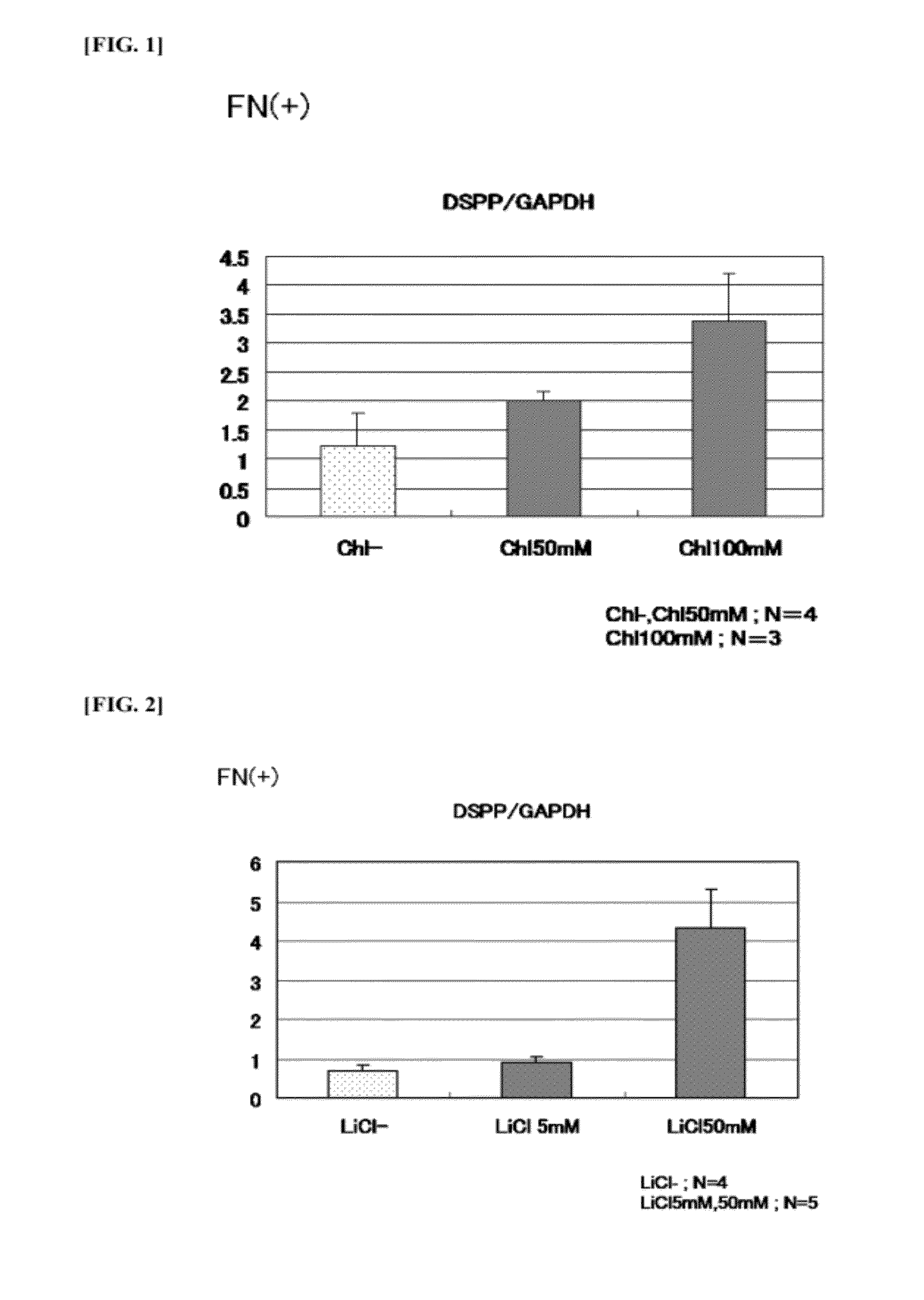Method for Inducing Differentiation of Dental Pulp Cells Into Odontoblasts
a technology of dental pulp cells and odontoblasts, which is applied in the field of regenerative medicine of dentin, can solve the problems of inability to expect to promote dentinogenesis, calcium hydroxide does not, and exacerbation of caries, so as to promote the subsequent dentinogenesis and enhance the expression of dspp
- Summary
- Abstract
- Description
- Claims
- Application Information
AI Technical Summary
Benefits of technology
Problems solved by technology
Method used
Image
Examples
example 1
Induction of Differentiation into Odontoblasts Using Sodium Chlorate (NaClO3)
[0061]In this example, MEDP cells as a pulp-derived cell line were cultured in a system including NaClO3, and the expression of Dspp in the cultured cells was confirmed. The expression of Dspp was confirmed by PCR.
[0062]The MEDP cells were cultured using a DMEM medium containing 10% v / v fetal bovine serum (FBS). The cells were suspended in the medium so that the number of the cells was 3.7×105 cells / ml, and 5 ml of the cell suspension were added to a culture vessel having a diameter of 6 cm and cultured. The culture was carried out using a culture vessel coated with fibronectin (FN) at 37±0.5° C. On day 1 of the culture, NaClO4 was added so that the final concentration was 50 mM or 100 mM, and the cells were cultured for an additional 7 days.
[0063]After mRNA had been extracted from the cultured cells using an RNeasy Mini Kit™ (manufactured by QIAGEN), reverse transcription was carried out using a PrimeScrip...
example 2
Induction of Differentiation into Odontoblasts Using Lithium Chloride (LiCl)
[0067]In this example, MEDP cells as a pulp-derived cell line were cultured in a system including LiCl, and the expression of Dspp in the cultured cells was confirmed. The expression of Dspp was confirmed by PCR.
[0068]A treatment for inducing differentiation was carried out by the same technique as that of Example 1 except that LiCl was used in place of NaClO3 and LiCl was added so that the final concentration was 5 mM or 50 mM on day 1 of the culture. Then, the expression of Dspp was confirmed.
[0069]The results confirmed that, in the culture of the pulp cells in the system including LiCl, the expression of Dspp was significantly enhanced and the differentiation of undifferentiated pulp cells into odontoblasts was induced. It is said that LiCl has an action of suppressing GSK-3. GSK-3 has a suppressive role in the Wnt signaling pathway, and LiCl is capable of directly activating the Wnt signaling pathway by ...
example 3
Induction of Differentiation into Odontoblasts Using Sodium Perchlorate (NaClO4)
[0070]In this example, MEDP cells as a pulp-derived cell line were cultured in a system including NaClO4, and the expression of Dspp in the cultured cells was confirmed. The expression of Dspp was confirmed by PCR.
[0071]A treatment for inducing differentiation was carried out by the same technique as that of Example 1 except that NaClO4 was used in place of NaClO3. Then, the expression of Dspp was confirmed.
PUM
 Login to View More
Login to View More Abstract
Description
Claims
Application Information
 Login to View More
Login to View More - R&D
- Intellectual Property
- Life Sciences
- Materials
- Tech Scout
- Unparalleled Data Quality
- Higher Quality Content
- 60% Fewer Hallucinations
Browse by: Latest US Patents, China's latest patents, Technical Efficacy Thesaurus, Application Domain, Technology Topic, Popular Technical Reports.
© 2025 PatSnap. All rights reserved.Legal|Privacy policy|Modern Slavery Act Transparency Statement|Sitemap|About US| Contact US: help@patsnap.com

